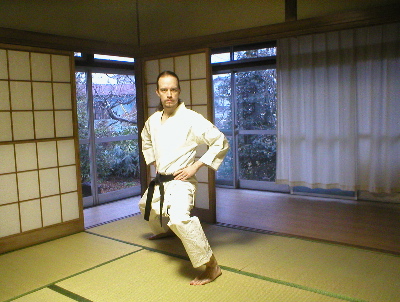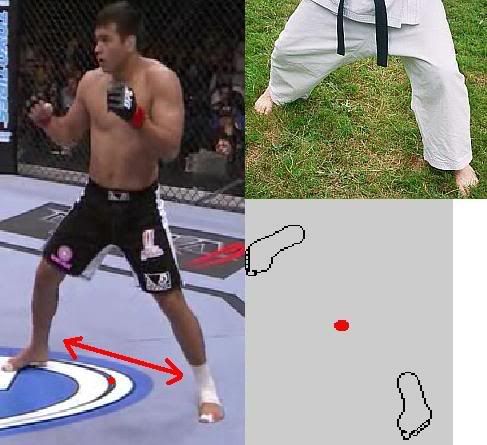I have two different types of "horse stances" that I use in Uechi kata. Most I believe don't try to make a distinction; I most definitely do. I differentiate the stances for the most part by two key features, which are intimately connected.
- The body at the hips is either bladed (1) or frontal (2).
- The back knee is either back (1) or more forwards (2).
The closest I've come is kiba dachi (1) vs. hangetsu dachi (2). However... If you Google kiba dachi, you get the kind where the shoulders are in line with the two knees rather than being turned more towards one direction.

Turn the shoulders to the left or the right, and you have a left or right bladed Uechi horse stance (using my terminology).
If you Google hangetsu dachi, you get something that is decidedly knock-kneed.

This is close... I prefer having the knee out a bit more.
This frontal stance of course is in contrast to zenkutsu dachi - the classic Shorin style front stance.

The difference between zenkutsu dachi vs. hangetsu dachi is...
- Near-locked rear leg vs. bent rear leg.
- Some lumbar lordosis vs. a pelvic tilt (thus minimizing lordosis as in Sanchin).

I'm not trying to get into a discussion about which stance is better. I use them all. In fact... Recently in a classic sequence of Uechi Sanseiryu, I'm shifting from bladed horse (for double roundhouse boshiken) to front stance (to drive gedan barai) to bladed horse (to do shoken scooop) to frontal horse (to do toss after scoop). The key here is getting the core to drive the arm techniques. The more I do that and relax the arms, the more I feel "natural" and athletic in my kata movement. The blade/frontal shift with the shoken scoop is also highly functional in that blading the torso helps if you goof in catching a kick.
There is precedent in martial arts for stance shifting like this. The Yang style tai chi form I learned (from Robert Smith) has these kids of smoothly-shifting deep stances. And this form is very much about teaching the practitioner how to generate energy from the large core muscles. You can call it chi if you want; I call it good athletic movement. A batter who shifts his deep stance as he swings the bat doesn't think a lot about it. He just does it. The pelvis turns a full 90 degrees. That's extreme, but then you're swinging a big piece of lumber.
Barry Bonds swings a bat.
I first got into doing this after noting another Uechika doing this shift (George Schreiffer from Florida.) The "aha" I got from seeing him do that helped me resolve the extremes of the two horse stances I've seen people do in Uechi, like Shinjo Seiyu's deep bladed horse stance

vs. George's more frontal horse. Basically you can do both, mix and match them, and actually use the transitions to generate energy.
Or so I think...
Comments on naming conventions, tendency to shift low stances (or not) in Uechi kata, etc. are appreciated. I'm comfortable with what I do, but not comfortable with what to call it all. And I'm trying to get a feeler for what others are or are not doing.
- Bill





